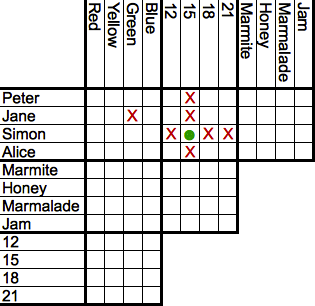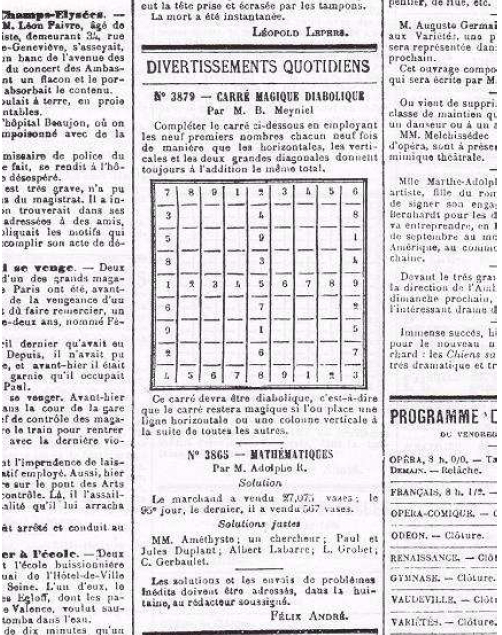|
Takuzu
Takuzu, also known as Binairo, is a logic puzzle involving placement of two symbols, often 1s and 0s, on a rectangular grid. The objective is to fill the grid with 1s and 0s, where there is an equal number of 1s and 0s in each row and column and no more than two of either number adjacent to each other. Additionally, there can be no identical rows or columns. Similar to Sudoku, each puzzle begins with several squares in the grid already filled. Names and variations The game is known as Binairo, Takuzu, Binero, Tohu-Wa-Vohu (Formless and Empty), Eins und Zwei (One and Two), Binary Puzzles, Binoxxo, Zernero, Tic-Tac-Logic, and Sudoku Binary. The names "Binairo" and "Takuzu" are trademarked in the European Union. The name "Binero" is trademarked in France by Editions Megastar. LinkedIn publishes a version of this game as well, called Tango. Certain names imply specific symbols being used. For example, Binary Puzzles use 1s and 0s (i.e. binary numbers), Tic-Tac-Logic uses Xs and Os ... [...More Info...] [...Related Items...] OR: [Wikipedia] [Google] [Baidu] |
Logic Puzzle
A logic puzzle is a puzzle deriving from the mathematics, mathematical field of deductive reasoning, deduction. History The logic puzzle was first produced by Charles Lutwidge Dodgson, who is better known under his pen name Lewis Carroll, the author of ''Alice's Adventures in Wonderland''. In his book ''The Game of Logic'' he introduced a game to solve problems such as confirming the conclusion "Some greyhounds are not fat" from the statements "No fat creatures run well" and "Some greyhounds run well". Puzzles like this, where we are given a list of premises and asked what can be deduced from them, are known as syllogisms. Dodgson goes on to construct much more complex puzzles consisting of up to 8 premises. In the second half of the 20th century mathematician Raymond Smullyan, Raymond M. Smullyan continued and expanded the branch of logic puzzles with books such as ''The Lady or the Tiger?'', ''To Mock a Mockingbird'' and ''Alice in Puzzle-Land''. He popularized the "knights a ... [...More Info...] [...Related Items...] OR: [Wikipedia] [Google] [Baidu] |
Sudoku
Sudoku (; ; originally called Number Place) is a logic puzzle, logic-based, combinatorics, combinatorial number-placement puzzle. In classic Sudoku, the objective is to fill a 9 × 9 grid with digits so that each column, each row, and each of the nine 3 × 3 subgrids that compose the grid (also called "boxes", "blocks", or "regions") contains all of the digits from 1 to 9. The puzzle setter provides a partially completed grid, which for a well-posed problem, well-posed puzzle has a single solution. French newspapers featured similar puzzles in the 19th century, and the modern form of the puzzle first appeared in 1979 puzzle books by Dell Magazines under the name Number Place. However, the puzzle type only began to gain widespread popularity in 1986 when it was published by the Japanese puzzle company Nikoli (publisher), Nikoli under the name Sudoku, meaning "single number". In newspapers outside of Japan, it first appeared in ''The Conway Daily Sun'' (New Hamp ... [...More Info...] [...Related Items...] OR: [Wikipedia] [Google] [Baidu] |
Le Point
''Le Point'' () is a French weekly political and conservative news magazine published in Paris. It is one of the three major French news magazines. ''Le Point'' was founded in 1972 by former journalists of ''L'Express'' and quickly rose to become a major competitor. The magazine has changed ownership multiple times since its inception and is currently owned by Artémis, an investment group of billionaire businessman François Pinault. History and profile ''Le Point'' was founded in September 1972 by a group of journalists who had, one year earlier, left the editorial team of ''L'Express'', which was then owned by Jean-Jacques Servan-Schreiber, a ''député'' (member of parliament) of the Parti Radical, a centrist party. The company operating ''Le Point'', ''Société d'exploitation de l'hebdomadaire Le Point'' (''SEBDO Le Point'') has its head office in the 14th arrondissement of Paris. The founders focused on readers' needs, which became ''Le Point''s ideal, published by L ... [...More Info...] [...Related Items...] OR: [Wikipedia] [Google] [Baidu] |
Tohu Wa-bohu
''Tohu wa-bohu'' or ''Tohu va-Vohu'' (Biblical Hebrew: ) is a Biblical Hebrew phrase found in the Genesis creation narrative ( Genesis 1:2) that describes the condition of the earth () immediately before the creation of light in Genesis 1:3. Numerous interpretations of this phrase are made by various theological sources. The King James Version translation of the phrase is "without form, and void", corresponding to Septuagint , "unseen and unformed". Text The words ''tohu'' and ''bohu'' also occur in parallel in , which the King James Version translates with the words "confusion" and "emptiness". The two Hebrew words are properly segolates, spelled ''tohuw'' and ''bohuw''.Wilhelm Gesenius, ''A Hebrew and English Lexicon'' (1906). Hebrew ''tohuw'' translates to "wasteness, that which is laid waste, desert; emptiness, vanity; nothing". ''Tohuw'' is frequently used in the Book of Isaiah in the sense of "vanity", but ''bohuw'' occurs nowhere else in the Hebrew Bible (outs ... [...More Info...] [...Related Items...] OR: [Wikipedia] [Google] [Baidu] |
EUIPO
The European Union Intellectual Property Office (EUIPO) () is a decentralised agency of the EU responsible for the registration of EU-wide unitary trade marks and industrial design rights. These exist alongside the intellectual property rights of individual EU member states, so the agency also works to harmonise EU-wide and national registration processes. Other responsibilities include the administration of the rights of certain products in the EU to carry geographical indications. EUIPO was founded in 1994 and was formerly known as the Office for Harmonization in the Internal Market (OHIM), but was renamed in March 2016 to reflect major reforms. The EUIPO is based in Alicante, Spain. Functions and activities Intellectual property registration The Office is in charge of managing the registration of the EU trade mark and the registered Community design and offers businesses and citizens exclusive rights for trade mark and design protection throughout the European Union ... [...More Info...] [...Related Items...] OR: [Wikipedia] [Google] [Baidu] |
Binary Number
A binary number is a number expressed in the Radix, base-2 numeral system or binary numeral system, a method for representing numbers that uses only two symbols for the natural numbers: typically "0" (zero) and "1" (one). A ''binary number'' may also refer to a rational number that has a finite representation in the binary numeral system, that is, the quotient of an integer by a power of two. The base-2 numeral system is a positional notation with a radix of 2. Each digit is referred to as a bit, or binary digit. Because of its straightforward implementation in digital electronic circuitry using logic gates, the binary system is used by almost all modern computer, computers and computer-based devices, as a preferred system of use, over various other human techniques of communication, because of the simplicity of the language and the noise immunity in physical implementation. History The modern binary number system was studied in Europe in the 16th and 17th centuries by Thoma ... [...More Info...] [...Related Items...] OR: [Wikipedia] [Google] [Baidu] |
Tic-tac-toe
Tic-tac-toe (American English), noughts and crosses (English in the Commonwealth of Nations, Commonwealth English), or Xs and Os (Canadian English, Canadian or Hiberno-English, Irish English) is a paper-and-pencil game for two players who take turns marking the spaces in a three-by-three grid, one with Xs and the other with Os. A player wins when they mark all three spaces of a row, column, or diagonal of the grid, whereupon they traditionally draw a line through those three marks to indicate the win. It is a solved game, with a forced draw assuming Best response, best play from both players. Names In American English, the game is known as "tic-tac-toe". It may also be spelled "tick-tack-toe", "tick-tat-toe", or "tit-tat-toe". In Commonwealth English (particularly British English, British, South African English, South African, Indian English, Indian, Australian English, Australian, and New Zealand English), the game is known as "noughts and crosses", alternatively spelled ... [...More Info...] [...Related Items...] OR: [Wikipedia] [Google] [Baidu] |
Zero-knowledge Proof
In cryptography, a zero-knowledge proof (also known as a ZK proof or ZKP) is a protocol in which one party (the prover) can convince another party (the verifier) that some given statement is true, without conveying to the verifier any information ''beyond'' the mere fact of that statement's truth. The intuition underlying zero-knowledge proofs is that it is trivial to prove possession of the relevant information simply by revealing it; the hard part is to prove this possession without revealing this information (or any aspect of it whatsoever). In light of the fact that one should be able to generate a proof of some statement ''only'' when in possession of certain secret information connected to the statement, the verifier, even after having become convinced of the statement's truth, should nonetheless remain unable to prove the statement to further third parties. Zero-knowledge proofs can be interactive, meaning that the prover and verifier exchange messages according to some pro ... [...More Info...] [...Related Items...] OR: [Wikipedia] [Google] [Baidu] |

